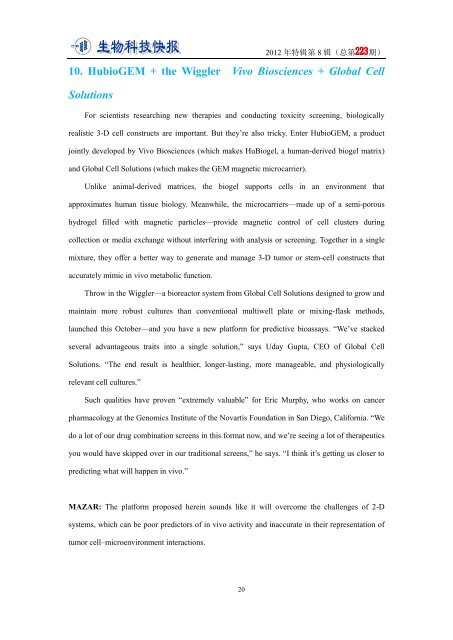2012 生命科学10 大创新 - 中国科学院成都生物研究所科技信息情报中心
2012 生命科学10 大创新 - 中国科学院成都生物研究所科技信息情报中心
2012 生命科学10 大创新 - 中国科学院成都生物研究所科技信息情报中心
You also want an ePaper? Increase the reach of your titles
YUMPU automatically turns print PDFs into web optimized ePapers that Google loves.
<strong>2012</strong> 年 特 辑 第 8 辑 ( 总 第 期 )<br />
10. HubioGEM + the Wiggler Vivo Biosciences + Global Cell<br />
Solutions<br />
For scientists researching new therapies and conducting toxicity screening, biologically<br />
realistic 3-D cell constructs are important. But they’re also tricky. Enter HubioGEM, a product<br />
jointly developed by Vivo Biosciences (which makes HuBiogel, a human-derived biogel matrix)<br />
and Global Cell Solutions (which makes the GEM magnetic microcarrier).<br />
Unlike animal-derived matrices, the biogel supports cells in an environment that<br />
approximates human tissue biology. Meanwhile, the microcarriers—made up of a semi-porous<br />
hydrogel filled with magnetic particles—provide magnetic control of cell clusters during<br />
collection or media exchange without interfering with analysis or screening. Together in a single<br />
mixture, they offer a better way to generate and manage 3-D tumor or stem-cell constructs that<br />
accurately mimic in vivo metabolic function.<br />
Throw in the Wiggler—a bioreactor system from Global Cell Solutions designed to grow and<br />
maintain more robust cultures than conventional multiwell plate or mixing-flask methods,<br />
launched this October—and you have a new platform for predictive bioassays. “We’ve stacked<br />
several advantageous traits into a single solution,” says Uday Gupta, CEO of Global Cell<br />
Solutions. “The end result is healthier, longer-lasting, more manageable, and physiologically<br />
relevant cell cultures.”<br />
Such qualities have proven “extremely valuable” for Eric Murphy, who works on cancer<br />
pharmacology at the Genomics Institute of the Novartis Foundation in San Diego, California. “We<br />
do a lot of our drug combination screens in this format now, and we’re seeing a lot of therapeutics<br />
you would have skipped over in our traditional screens,” he says. “I think it’s getting us closer to<br />
predicting what will happen in vivo.”<br />
MAZAR: The platform proposed herein sounds like it will overcome the challenges of 2-D<br />
systems, which can be poor predictors of in vivo activity and inaccurate in their representation of<br />
tumor cell–microenvironment interactions.<br />
20








